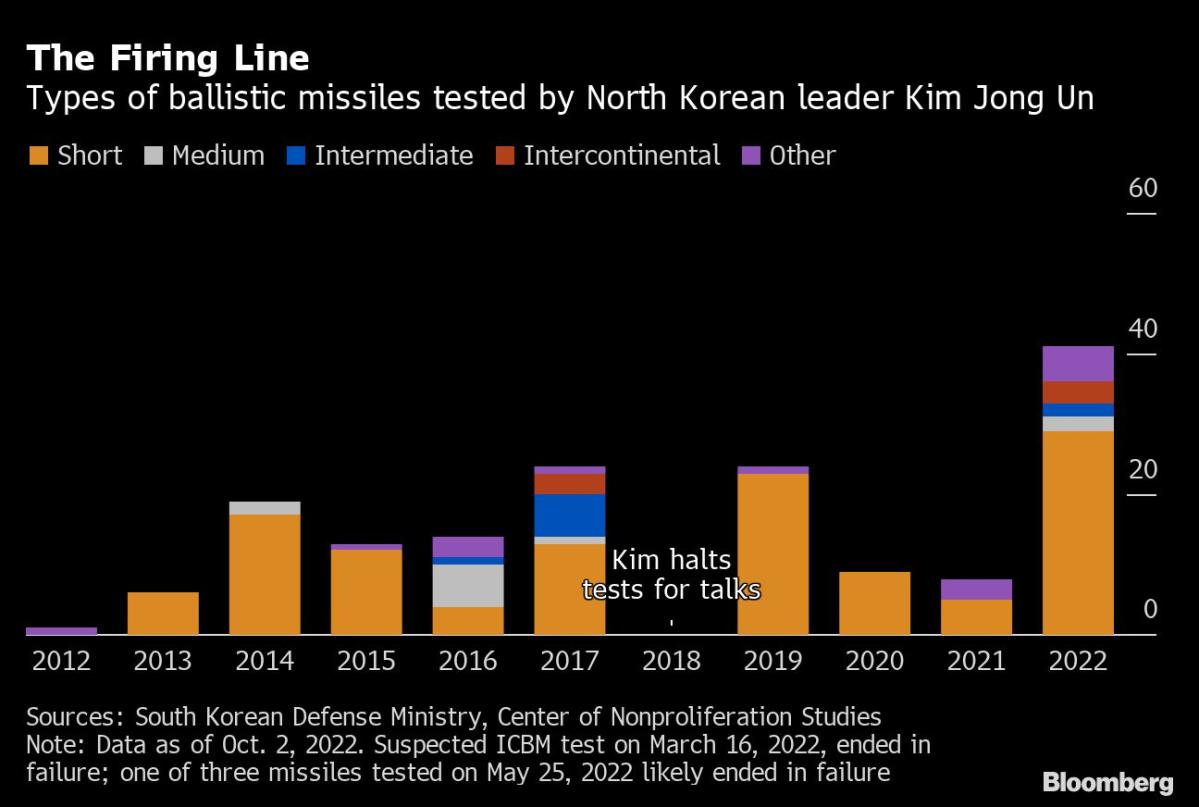
(Bloomberg) — Kim Jong Un said he launched a new ballistic missile and simulated “tactical” nuclear strikes during recent military drills, in the latest sign that North Korea is preparing for its first atomic test in five years.
Most Read from Bloomberg
Kim described a series of exercises since Sept. 25, which included the first missile fired over Japan in five years, as a “severe warning” to the US and its allies, the state-run Korean Central News Agency said Monday. The drills included simulated nuclear strikes on airports in South Korea, tests of underwater missile silos and rocket attacks on seaports, the report said, describing the moves as responses to US-led naval exercises.
The weapon that was fired over Japan into the Western Pacific on Oct. 4 was a “new-type ground-to-ground intermediate-range ballistic missile,” KCNA said. The launch was only the most provocative of a dozen missiles fired off over the past two weeks, prompting the US to sent the USS Ronald Reagan aircraft carrier group back to nearby waters.
Kim reaffirmed his opposition to negotiations with the US, after last month declaring that North Korea would “never give up nuclear arms or denuclearize first.” On Sunday, National Security Council spokesman John Kirby said in a Sunday an appearance on ABC’s “This Week” that its offer for talks still stands, but that the US had the capabilities to respond if Kim chose to escalate.
North Korea’s claimed advances couldn’t immediately be verified, and the regime hasn’t clearly demonstrated the technology needed to arm and deploy tactical nuclear weapons. The US and South Korea have warned that Kim could be preparing for his first nuclear test since 2017, something that would be necessary to prove that capability.
“I predict this means that North Korea will conduct a nuclear test in a near future,” said Yang Moo-jin, a professor at the University of North Korean Studies in Seoul who has advised the South Korean government. He said that such a demonstration was most likely between the end of Communist Party congress in Beijing and the US midterm elections.
The KCNA report shed light on Kim’s activities during an unusual monthlong absence from state media, which prompted speculation about health and whereabouts. The publication came on a day that North Korea celebrates the founding of the ruling Workers’ Party of Korea, an event that is often marked with displays of military might.
Until Monday’s dispatch, North Korea had been unusually quiet about the nature of its latest round of tests. That, along with rapid, tit-for-tat nature of the launches, suggests that North Korea was attempting to portray these weapons system as operational and ready to use in the event of a conflict.
The US, South Korea and Japan have stepped up military drills in the region in response to Kim’s continued nuclear moves, including passing a law last month that expanded the circumstances under which the regime could use atomic weapons. Kim has so far refused US President Joe Biden’s overtures to resume nuclear talks stalled for more than three years.
Kim blamed allied military threats for his refusal to return to talks. “With an even more powerful and resolute will and action, we should send an even clearer signal to the enemies who are escalating the tensions in the region by endlessly involving huge armed forces,” KCNA said, citing Kim.
The North Korean leader oversaw a “large-scale air-attack combined drill” as part of the exercises, according to KNCA. The report recounted the “endless happiness and delight” of the “gallant combat pilots” over being called by Kim to participate in the drills.
“The moment he appeared, all the combat pilots raised stormy cheers of ‘Hurrah!’ paying the highest tribute to the invincible and illustrious commander, who fully demonstrates to the whole world the absolute dignity and national prestige of the powerful DPRK,” the report said.
The office of South Korean President Yoon Suk Yeol said in a statement on Monday that protecting the nation’s people “is a matter of reality.”
“It is important to accurately recognize the current grave state of security in the Korean Peninsula and Northeast Asia and be properly prepared,” it added.
Most Read from Bloomberg Businessweek
©2022 Bloomberg L.P.




